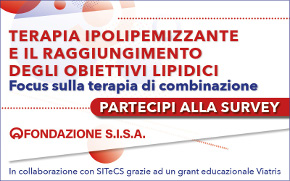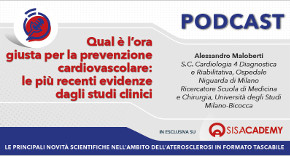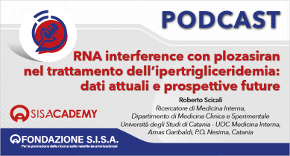 Rivista in lingua italiana
Rivista in lingua italiana
riservata ai Soci SISA
Ultimo numero:
Anno 16 • N.1/2025
SISANews
HOPE-3. Meglio la rosuvastatina che il candesartan nei pazienti a rischio intermedio
HOPE-3 è uno studio in doppio cieco, randomizzato e controllato che ha arruolato 12.705 pazienti a rischio intermedio (colesterolo LDL medio 128 mg/dL, pressione arteriosa media 138/82 mmHg) senza storia di patologia cardiovascolare. Lo studio ha valutato gli effetti della terapia con rosuvastatina 10 mg/die, con candesartan 16 mg+idroclorotiazide 12.5 mg/die e con la combinazione dei due trattamenti verso placebo. La terapia con rosuvastatina è risultata in una riduzione del 24% dell'incidenza di eventi cardiovascolari (morte cardiovascolare, infarto e ictus cerebrale non fatale), mentre l'incidenza di eventi con i soli antiipertensivi non è risultata significativamente diversa dal placebo, anche se la terapia aveva ridotto la pressione arteriosa in media di 6.0/3.0 mmHg. Nel sottogruppo di pazienti con ipertensione (PA sistolica >144 mmHg) si è rilevata comunque una riduzione del 27% degli eventi cardiovascolari. Il trattamento combinato rosuvastatina+antiipertensivi è risultato in una protezione dagli eventi cardiovascolari maggiore di quella osservata con il trattamento con la sola rosuvastatina (4% nel gruppo di trattamento e 5% nel gruppo placebo).
![]()
Blood-Pressure Lowering in Intermediate-Risk Persons without Cardiovascular Disease
Lonn EM, Bosch J, López-Jaramillo P, Zhu J, Liu L, Pais P, Diaz R, Xavier D, Sliwa K, Dans A, Avezum A, Piegas LS, Keltai K, Keltai M, Chazova I, Peters RJ, Held C, Yusoff K, Lewis BS, Jansky P, Parkhomenko A, Khunti K, Toff WD, Reid CM, Varigos J, Leiter LA, Molina DI, McKelvie R, Pogue J, Wilkinson J, Jung H, Dagenais G, Yusuf S; HOPE-3 Investigators
New Engl J Med 2016;374:2009-2020
BACKGROUND: Antihypertensive therapy reduces the risk of cardiovascular events among high-risk persons and among those with a systolic blood pressure of 160 mm Hg or higher, but its role in persons at intermediate risk and with lower blood pressure is unclear.
METHODS: In one comparison from a 2-by-2 factorial trial, we randomly assigned 12,705 participants at intermediate risk who did not have cardiovascular disease to receive either candesartan at a dose of 16 mg per day plus hydrochlorothiazide at a dose of 12.5 mg per day or placebo. The first coprimary outcome was the composite of death from cardiovascular causes, nonfatal myocardial infarction, or nonfatal stroke; the second coprimary outcome additionally included resuscitated cardiac arrest, heart failure, and revascularization. The median follow-up was 5.6 years.
RESULTS: The mean blood pressure of the participants at baseline was 138.1/81.9 mm Hg; the decrease in blood pressure was 6.0/3.0 mm Hg greater in the active-treatment group than in the placebo group. The first coprimary outcome occurred in 260 participants (4.1%) in the active-treatment group and in 279 (4.4%) in the placebo group (hazard ratio, 0.93; 95% confidence interval [CI], 0.79 to 1.10; P=0.40); the second coprimary outcome occurred in 312 participants (4.9%) and 328 participants (5.2%), respectively (hazard ratio, 0.95; 95% CI, 0.81 to 1.11; P=0.51). In one of the three prespecified hypothesis-based subgroups, participants in the subgroup for the upper third of systolic blood pressure (>143.5 mm Hg) who were in the active-treatment group had significantly lower rates of the first and second coprimary outcomes than those in the placebo group; effects were neutral in the middle and lower thirds (P=0.02 and P=0.009, respectively, for trend in the two outcomes).
CONCLUSIONS: Therapy with candesartan at a dose of 16 mg per day plus hydrochlorothiazide at a dose of 12.5 mg per day was not associated with a lower rate of major cardiovascular events than placebo among persons at intermediate risk who did not have cardiovascular disease.
New Engl J Med 2016;374:2009-2020
![]()
Cholesterol Lowering in Intermediate-Risk Persons without Cardiovascular Disease
Yusuf S, Bosch J, Dagenais G, Zhu J, Xavier D, Liu L, Pais P, López-Jaramillo P, Leiter LA, Dans A, Avezum A, Piegas LS, Parkhomenko A, Keltai K, Keltai M, Sliwa K, Peters RJ, Held C, Chazova I, Yusoff K, Lewis BS, Jansky P, Khunti K, Toff WD, Reid CM, Varigos J, Sanchez-Vallejo G, McKelvie R, Pogue J, Jung H, Gao P, Diaz R, Lonn E; HOPE-3 Investigators
New Engl J Med 2016;374:2021-2031
BACKGROUND: Previous trials have shown that the use of statins to lower cholesterol reduces the risk of cardiovascular events among persons without cardiovascular disease. Those trials have involved persons with elevated lipid levels or inflammatory markers and involved mainly white persons. It is unclear whether the benefits of statins can be extended to an intermediate-risk, ethnically diverse population without cardiovascular disease.
METHODS: In one comparison from a 2-by-2 factorial trial, we randomly assigned 12,705 participants in 21 countries who did not have cardiovascular disease and were at intermediate risk to receive rosuvastatin at a dose of 10 mg per day or placebo. The first coprimary outcome was the composite of death from cardiovascular causes, nonfatal myocardial infarction, or nonfatal stroke, and the second coprimary outcome additionally included revascularization, heart failure, and resuscitated cardiac arrest. The median follow-up was 5.6 years.
RESULTS: The overall mean low-density lipoprotein cholesterol level was 26.5% lower in the rosuvastatin group than in the placebo group. The first coprimary outcome occurred in 235 participants (3.7%) in the rosuvastatin group and in 304 participants (4.8%) in the placebo group (hazard ratio, 0.76; 95% confidence interval [CI], 0.64 to 0.91; P=0.002). The results for the second coprimary outcome were consistent with the results for the first (occurring in 277 participants [4.4%] in the rosuvastatin group and in 363 participants [5.7%] in the placebo group; hazard ratio, 0.75; 95% CI, 0.64 to 0.88; P<0.001). The results were also consistent in subgroups defined according to cardiovascular risk at baseline, lipid level, C-reactive protein level, blood pressure, and race or ethnic group. In the rosuvastatin group, there was no excess of diabetes or cancers, but there was an excess of cataract surgery (in 3.8% of the participants, vs. 3.1% in the placebo group; P=0.02) and muscle symptoms (in 5.8% of the participants, vs. 4.7% in the placebo group; P=0.005).
CONCLUSIONS: Treatment with rosuvastatin at a dose of 10 mg per day resulted in a significantly lower risk of cardiovascular events than placebo in an intermediate-risk, ethnically diverse population without cardiovascular disease.
New Engl J Med 2016;374:2021-2031
![]()
Blood-Pressure and Cholesterol Lowering in Persons without Cardiovascular Disease
Yusuf S, Lonn E, Pais P, Bosch J, López-Jaramillo P, Zhu J, Xavier D, Avezum A, Leiter LA, Piegas LS, Parkhomenko A, Keltai M, Keltai K, Sliwa K, Chazova I, Peters RJ, Held C, Yusoff K, Lewis BS, Jansky P, Khunti K, Toff WD, Reid CM, Varigos J, Accini JL, McKelvie R, Pogue J, Jung H, Liu L, Diaz R, Dans A, Dagenais G; HOPE-3 Investigators
New Engl J Med 2016;374:2032-2043
BACKGROUND: Elevated blood pressure and elevated low-density lipoprotein (LDL) cholesterol increase the risk of cardiovascular disease. Lowering both should reduce the risk of cardiovascular events substantially.
METHODS: In a trial with 2-by-2 factorial design, we randomly assigned 12,705 participants at intermediate risk who did not have cardiovascular disease to rosuvastatin (10 mg per day) or placebo and to candesartan (16 mg per day) plus hydrochlorothiazide (12.5 mg per day) or placebo. In the analyses reported here, we compared the 3180 participants assigned to combined therapy (with rosuvastatin and the two antihypertensive agents) with the 3168 participants assigned to dual placebo. The first coprimary outcome was the composite of death from cardiovascular causes, nonfatal myocardial infarction, or nonfatal stroke, and the second coprimary outcome additionally included heart failure, cardiac arrest, or revascularization. The median follow-up was 5.6 years.
RESULTS: The decrease in the LDL cholesterol level was 33.7 mg per deciliter (0.87 mmol per liter) greater in the combined-therapy group than in the dual-placebo group, and the decrease in systolic blood pressure was 6.2 mm Hg greater with combined therapy than with dual placebo. The first coprimary outcome occurred in 113 participants (3.6%) in the combined-therapy group and in 157 (5.0%) in the dual-placebo group (hazard ratio, 0.71; 95% confidence interval [CI], 0.56 to 0.90; P=0.005). The second coprimary outcome occurred in 136 participants (4.3%) and 187 participants (5.9%), respectively (hazard ratio, 0.72; 95% CI, 0.57 to 0.89; P=0.003). Muscle weakness and dizziness were more common in the combined-therapy group than in the dual-placebo group, but the overall rate of discontinuation of the trial regimen was similar in the two groups.
CONCLUSIONS: The combination of rosuvastatin (10 mg per day), candesartan (16 mg per day), and hydrochlorothiazide (12.5 mg per day) was associated with a significantly lower rate of cardiovascular events than dual placebo among persons at intermediate risk who did not have cardiovascular disease.
New Engl J Med 2016;374:2032-2043

Area Soci
Eventi
39° Congresso Nazionale
 39° Congresso Nazionale
39° Congresso NazionaleRoma, 23-25 novembre 2025
Save the date




 Spring Meeting Gruppi Giovani SID, SIGG, SIIA, SIMI, SIPREC, SISA
Spring Meeting Gruppi Giovani SID, SIGG, SIIA, SIMI, SIPREC, SISARimini, 6-8 aprile 2025
[continua a leggere]
 SISA LIPID ACADEMY - Corso avanzato di lipidologia clinica
SISA LIPID ACADEMY - Corso avanzato di lipidologia clinicaModena, 4-5 Luglio 2024
[continua a leggere]Giornale Italiano Arteriosclerosi
HoFH today
 Rivista Italiana della
Rivista Italiana della
Ipercolesterolemia
Familiare Omozigote
Anno 6 • N.1/2024
Rivista NMCD
Diateca
[continua a leggere]
[continua a leggere]
Newsletter
il vostro indirizzo di posta elettronica
Progetto LIPIGEN

Nuovo sito dedicato al Progetto LIPIGEN
Progetto LIPIGEN - Vecchio portale
E' necessario essere loggati come utente
Lipigen per poter accedere alla pagina
PROject Statin Intolerance SISA
PROSISA – PROject Statin Intolerance SISA
E' necessario essere loggati come utente
PROSISA per poter accedere alla pagina
GILA - Lipoprotein Aferesi
Gruppo Interdisciplinare Lipoprotein Aferesi
(Accesso Gruppo GILA-Lipoprotein Aferesi)
E' necessario essere loggati come utente del Gruppo GILA per poter accedere
Gruppo Interdisciplinare Lipoprotein Aferesi
(Documentazione ad accesso libero)
Pagina informativa per medici e pazienti










